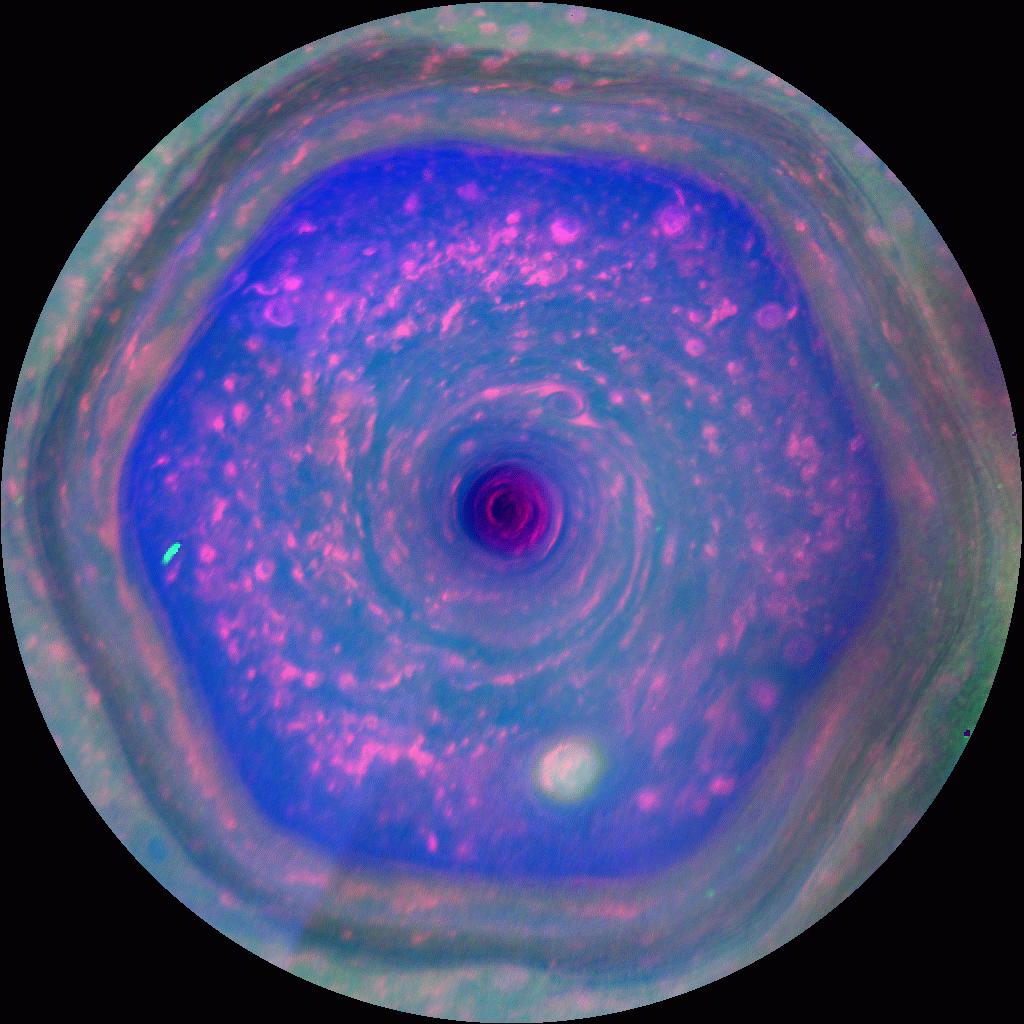#saturn hexagon
Text

Saturn's north polar hexagon (November 27, 2012)
#astronomy#krakenmare#solar system#astrophotography#outer space#space#nasa#thank you nasa#saturn#saturn weather#saturn hexagon#hurricanes#storms
111 notes
·
View notes
Text

Saturn's north pole is a hexagon.
98 notes
·
View notes
Photo


#Saturn#Saturn's rings#Saturn's hexagon#space#astronomy#astrophotography#religion is a mental illness
55 notes
·
View notes
Text

There is a giant hexagon at the north pole of Saturn 🪐
It's a complex system of clouds and storms that's 29,000 km across—more than twice as wide as Earth.
Credit: NASA/JPL-Caltech/SSI/Kevin M. Gill (@kevinmgill)
#nasa#astronomy#astrophotography#solar system#astrophysics#hubble#nebula#physics#james webb space technology#james webb images#saturn#hexagon
36 notes
·
View notes
Text
Saturn's Northern Hexagon

Why would clouds form a hexagon on Saturn? Nobody is sure. Originally discovered during the Voyager flybys of Saturn in the 1980s, nobody has ever seen anything like it anywhere else in the Solar System. Acquiring its first sunlit views of far northern Saturn in late 2012, the Cassini spacecraft's wide-angle camera recorded this stunning, false-color image of the ringed planet's north pole. The composite of near-infrared image data results in red hues for low clouds and green for high ones, giving the Saturnian cloudscape a vivid appearance. This and similar images show the stability of the hexagon even 20+ years after Voyager. Movies of Saturn's North Pole show the cloud structure maintaining its hexagonal structure while rotating. Unlike individual clouds appearing like a hexagon on Earth, the Saturn cloud pattern appears to have six well defined sides of nearly equal length. Four Earths could fit inside the hexagon. Beyond the cloud tops at the upper right, arcs of the planet's eye-catching rings are tinted bright blue.
Image Credit & Copyright: NASA, ESA, JPL, SSI, Cassini Imaging Team
#2023#your friendly neighborhood space nerd#space#nasa#esa#jpl#saturn#hexagon#cloud formation#solar system#cassini#flyby#astronomy
12 notes
·
View notes
Text

Saturn Claus, 2021. Digital commission.
3 notes
·
View notes
Video
A cosmic hurricane by European Space Agency
Via Flickr:
The giant planet Saturn is mostly a gigantic ball of rotating gas, completely unlike our solid home planet. But Earth and Saturn do have something in common: weather, although the gas giant is home to some of the most bizarre weather in our Solar System, such as the swirling storm shown in this Cassini view. Known as “the hexagon”, this weather feature is an intense, six-sided jet stream at Saturn’s north pole. Spanning some 30 000 km across, it hosts howling 320 km/h winds that spiral around a massive storm rotating anticlockwise at the heart of the region. Numerous small vortices rotate in the opposite direction to the central storm and are dragged around with the jet stream, creating a terrifically turbulent region. While a hurricane on Earth may last a week or more, the hexagon has been raging for decades, and shows no signs of letting up. This false-colour image of the hexagon was made using ultraviolet, visible and infrared filters to highlight different regions. The dark centre of the image shows the large central storm and its eye, which is up to 50 times bigger than a terrestrial hurricane eye. The small vortices show up as pink-red clumps. Towards the lower right of the frame is a white-tinted oval storm that is bigger than any of the others — this is the largest of the vortices at some 3500 km across, twice the size of the largest hurricane ever recorded on Earth. The darker blue region within the hexagon is filled with small haze particles, whereas the paler blue region is dominated by larger particles. This divide is caused by the hexagonal jet stream acting as a shepherding barrier — large particles cannot enter the hexagon from the outside. These large particles are created when sunlight shines onto Saturn’s atmosphere, something that only started relatively recently in the northern hemisphere with the beginning of northern spring in August 2009. Cassini will continue to track changes in the hexagon, monitoring its contents, shape and behaviour as summer reaches Saturn’s northern hemisphere in 2017. The Cassini–Huygens mission is a cooperative project of NASA, ESA and Italy's ASI space agency. An animated version is available here: www.jpl.nasa.gov/spaceimages/details.php?id=PIA17652 Credit: NASA/JPL-Caltech/SSI/Hampton University
0 notes
Text
youtube
It’s fascinating how popular the hexagon shape is in nature. Everything from honey 🍯 to the eyes of bees 🐝 to snow flakes ❄️ to even Saturn’s 🪐 North Pole.
0 notes
Text
my merkabah breaking during ramadan...
#whats its meaning#to my chakras ?#its obviously seen in jewish mysticism... being the star of david... the hexagon storm on top of saturn...
0 notes
Text
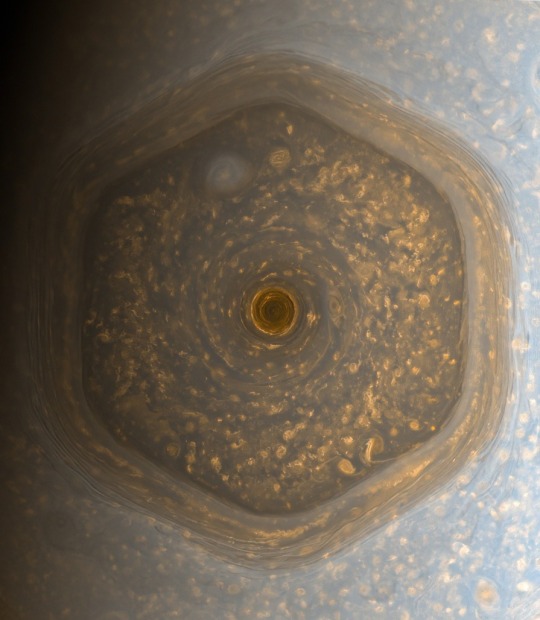
A hexagonal storm with a diameter of 25,000 km raging at the north pole of Saturn.
5K notes
·
View notes
Photo

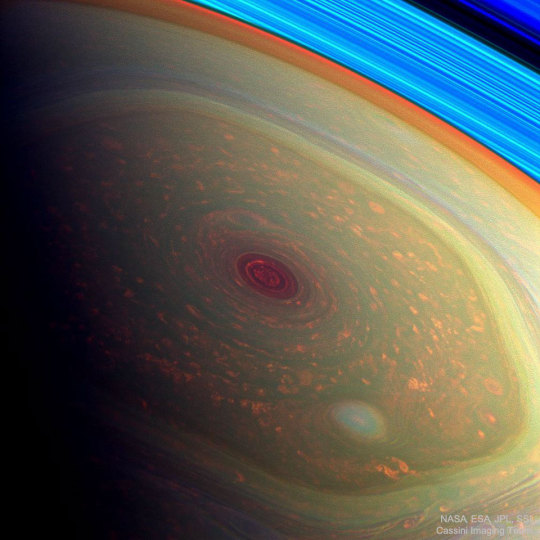

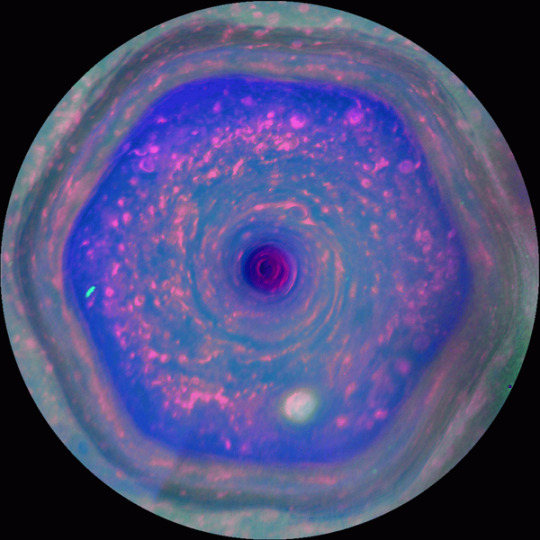


Saturn's Northern Hexagon © NASA Cassini
#cassini#nasa#space#saturn#apod#astrophotography#universe#stars#solar system#astronomy#cosmos#planet#nebula#planets#galaxy#night sketches
3K notes
·
View notes
Text

Cassini: hexagonal wave pattern in the clouds of Saturn's north pole (December 1, 2008)
#cassini#cassini huygens#krakenmare#astronomy#astrophotography#solar system#outer space#space#nasa#esa#european space agency#saturn#saturn north pole#saturn hurricane#saturn weather#gas giant
92 notes
·
View notes
Photo

Saturn's hexagon storm, America for scale
557 notes
·
View notes
Photo

2023 August 25
A Season of Saturn
Image Credit & Copyright: Andy Casely
Explanation: Ringed planet Saturn will be at its 2023 opposition, opposite the Sun in Earth's skies, on August 27. While that puts the sixth planet from the Sun at its brightest and well-placed for viewing, its beautiful ring system isn't visible to the unaided eye. Still, this sequence of telescopic images taken a year apart over the last six years follows both Saturn and rings as seen from inner planet Earth. The gas giant's ring plane tilts from most open in 2018 to approaching edge-on in 2023 (top to bottom). That's summer to nearly the autumn equinox for Saturn's northern hemisphere. In the sharp planetary portraits, Saturn's northern hexagon and a large storm system are clearly visible in 2018. In 2023, ice moon Tethys is transiting, casting its shadow across southern hemisphere cloud bands, while Saturn's cold blue south pole is emerging from almost a decade of winter darkness.
∞ Source: apod.nasa.gov/apod/ap230825.html
163 notes
·
View notes
Photo

Saturn's north polar vortex compared to continental US.
Related: North America and the Great Red Spot on Jupiter >>
Saturn's hexagon is a persistent approximately hexagonal cloud pattern around the north pole of the planet Saturn, located at about 78°N. The sides of the hexagon are about 14,500 km (9,000 mi) long, which is about 2,000 km (1,200 mi) longer than the diameter of Earth. The hexagon may be a bit more than 29,000 km (18,000 mi) wide, may be 300 km (190 mi) high, and may be a jet stream made of atmospheric gases moving at 320 km/h (200 mph). It rotates with a period of 10h 39m 24s, the same period as Saturn's radio emissions from its interior.
1K notes
·
View notes
Note
Do you know what the deal is with the black cube conspiracy/cult?
Basically, many cultures around the world have important objects or places that heavily feature black cubes, the two big examples being the Kaaba at Mecca and jewish tefillin boxes.
Additionally, the planet Saturn has a large dark storm on its north pole. The storm is hexagonal, as if it is several corners of a large, dark cube.
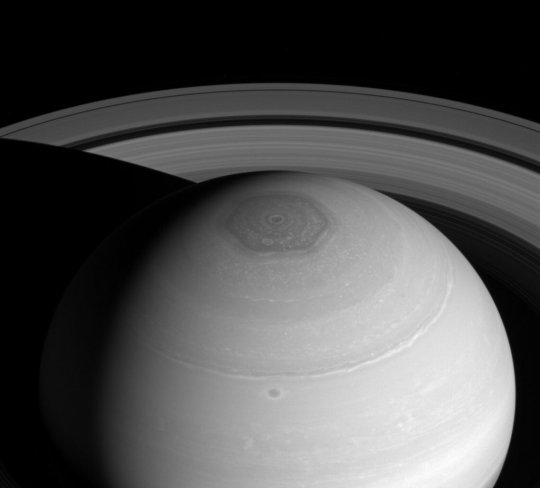
The conspiracy goes that all these instances of black cubes are actually the result of an ancient primordial cult of saturn-worshippers.
This idea of the Cult of Saturn is fringe, even for the conspiracy world, and it almost always gets folded into a David Icke style antisemitism/Islamophobia.
1K notes
·
View notes
